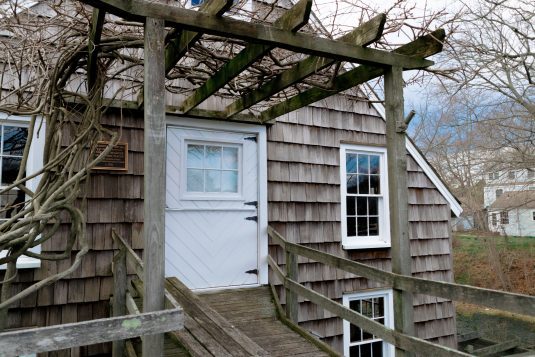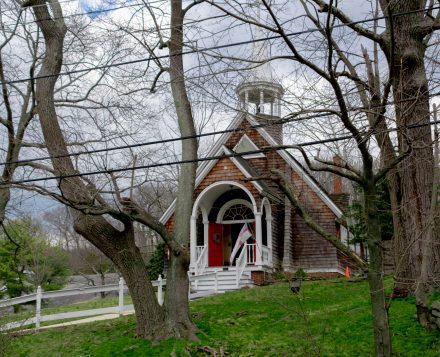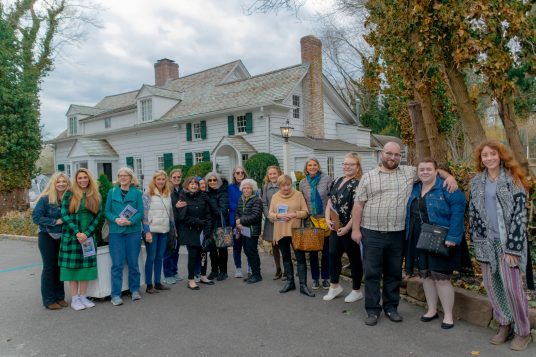By Cayla Rosenhagen

For centuries, the Three Village area has been home to fearless and heroic women who were ahead of their time. During the Ward Melville Heritage Organization’s (WMHO) Women’s History Walking Tour: “Against the Grain” on March 25, eager listeners heard tales of these courageous ladies, spanning from colonial times to the 20th century.
When I arrived in Stony Brook Village for the 3:50 tour, blooming daffodils and crocuses were sprouting up across the town, celebrating the recent arrival of spring. Our group met at the historic Grist Mill, where I met the other participants and our guide, Kayla Cheshire. Kayla has worked as the WMHO’s education and outreach manager for about three years and is a passionate and knowledgeable history buff.
The event attracted history enthusiasts from all over, however, many of the participants were locals. We were even fortunate to have descendants of a local historic figure, suffragette, conservationist, and town founder Jennie Melville among us.
We gathered around Kayla as she told us about the history of the area, including how it was home to conductors of the Underground Railroad in the mid-1800s. According to legend, conductors would use coded quilts to help enslaved people, who were escaping from the still-legal slave trade in the South, along their way to freedom. Details of the quilts, including morningstar and hourglass symbols would indicate the time and type of planned journeys to the next stations, bringing them one step closer to Canada. For instance, a squiggly emblem called the “Drunkard’s Path” implied the path they had to take was a difficult, zigzagged one, possibly through rough terrain and rivers, so they wouldn’t be tracked by bounty hunters.
The tour proceeded to All Souls Episcopal Church on Main Street, then to the Stony Brook Village Center, just in time to see the majestic eagle atop the Post Office flap its wings at 4 p.m. Here we learned of philanthropist and town matriarch Dorothy Melville, wife of Ward Melville, who was known as Stony Brook’s “fairy godmother.” She was a crucial contributor to the Stony Brook Community Fund and the Museums at Stony Brook and is credited with making the village handicap accessible.
Our next stop was The Jazz Loft. Its rich history included being utilized as a fire department in the early 1900s. In 1935, the building was transformed into a museum by the Melville family and prominent local Dr. Winifred Curtis, among others. Over time, the museum changed locations, and is now called the Long Island Museum on Route 25A.
The tour came to a close at the fascinatingly historic Three Village Inn. We learned about the inn’s former owners including Richard Hallock, Jonas Smith, and Jennie Melville, and its former uses as a private residence, tea room, and finally an inn. After the last story was told, Kayla offered us all free desserts with the purchase of an entrée at the Inn and told us about some of the upcoming happenings around town.
On Saturday, April 23rd, the entire village will honor spring with Spring Appreciation Day, which entails live music, a car show, a scavenger hunt, and a petting zoo. Admission is free and the events will take place between 1:30 and 3:30 PM.
The Women’s History Walking Tour is now available by request for private groups. Additionally, the WMHO offers “Secrets of Stony Brook Village” to the public throughout the season, with completely unique and newly uncovered stories and legends about the town. The tours will be held on April 7 and 21, as well as on June 2 and 16. There are two sessions each on these days, one at 11:50 a.m. and another at 3:50 p.m. The tours are $10 per person and the WMHO asks you to please call ahead to make a reservation at 631-751-2244.
Visitors can learn even more about the stories of Stony Brook by taking a tour of the 300-year-old Grist Mill. The historic, working mill will open again on April 16th, and Sunday tours will be available all season long, from April 24 through October.
The Ward Melville Historical Organization plays a crucial role in supporting local history. You, too, can do your part by supporting them. The WMHO suggests you can help by making general fund donations, purchasing a memorial plaque, or by sponsoring an event or historic property. The organization also has several volunteer opportunities. Please visit wmho.org/support-wmho/ for more information on how to get involved.









